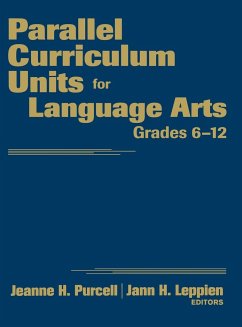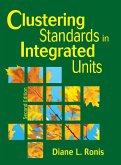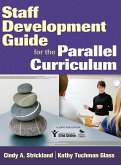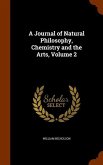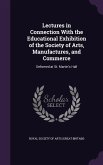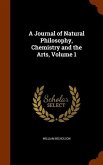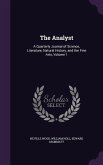Schade – dieser Artikel ist leider ausverkauft. Sobald wir wissen, ob und wann der Artikel wieder verfügbar ist, informieren wir Sie an dieser Stelle.
- Gebundenes Buch
- Merkliste
- Auf die Merkliste
- Bewerten Bewerten
- Teilen
- Produkt teilen
- Produkterinnerung
- Produkterinnerung
Sample units demonstrate how to use the Parallel Curriculum Model to design high-quality curriculum in language arts. Each unit includes instructions, assessments, and skills/standards.
Andere Kunden interessierten sich auch für
![Clustering Standards in Integrated Units Clustering Standards in Integrated Units]() Diane L. RonisClustering Standards in Integrated Units83,99 €
Diane L. RonisClustering Standards in Integrated Units83,99 €![Staff Development Guide for the Parallel Curriculum Staff Development Guide for the Parallel Curriculum]() Cindy A. StricklandStaff Development Guide for the Parallel Curriculum88,99 €
Cindy A. StricklandStaff Development Guide for the Parallel Curriculum88,99 €![Parallel Societies of International Students in Australia Parallel Societies of International Students in Australia]() Catherine GomesParallel Societies of International Students in Australia198,99 €
Catherine GomesParallel Societies of International Students in Australia198,99 €![A Journal of Natural Philosophy, Chemistry and the Arts, Volume 2 A Journal of Natural Philosophy, Chemistry and the Arts, Volume 2]() William NicholsonA Journal of Natural Philosophy, Chemistry and the Arts, Volume 245,99 €
William NicholsonA Journal of Natural Philosophy, Chemistry and the Arts, Volume 245,99 €![Lectures in Connection With the Educational Exhibition of the Society of Arts, Manufactures, and Commerce: Delivered at St. Martin's Hall Lectures in Connection With the Educational Exhibition of the Society of Arts, Manufactures, and Commerce: Delivered at St. Martin's Hall]() Lectures in Connection With the Educational Exhibition of the Society of Arts, Manufactures, and Commerce: Delivered at St. Martin's Hall36,99 €
Lectures in Connection With the Educational Exhibition of the Society of Arts, Manufactures, and Commerce: Delivered at St. Martin's Hall36,99 €![A Journal of Natural Philosophy, Chemistry and the Arts, Volume 1 A Journal of Natural Philosophy, Chemistry and the Arts, Volume 1]() William NicholsonA Journal of Natural Philosophy, Chemistry and the Arts, Volume 147,99 €
William NicholsonA Journal of Natural Philosophy, Chemistry and the Arts, Volume 147,99 €![The Analyst: A Quarterly Journal of Science, Literature, Natural History, and the Fine Arts, Volume 1 The Analyst: A Quarterly Journal of Science, Literature, Natural History, and the Fine Arts, Volume 1]() Neville WoodThe Analyst: A Quarterly Journal of Science, Literature, Natural History, and the Fine Arts, Volume 143,99 €
Neville WoodThe Analyst: A Quarterly Journal of Science, Literature, Natural History, and the Fine Arts, Volume 143,99 €-
Sample units demonstrate how to use the Parallel Curriculum Model to design high-quality curriculum in language arts. Each unit includes instructions, assessments, and skills/standards.
Produktdetails
- Produktdetails
- Verlag: Corwin
- Seitenzahl: 232
- Erscheinungstermin: 7. Oktober 2009
- Englisch
- Abmessung: 286mm x 221mm x 17mm
- Gewicht: 855g
- ISBN-13: 9781412965378
- ISBN-10: 1412965373
- Artikelnr.: 26378198
- Herstellerkennzeichnung
- Libri GmbH
- Europaallee 1
- 36244 Bad Hersfeld
- gpsr@libri.de
- Verlag: Corwin
- Seitenzahl: 232
- Erscheinungstermin: 7. Oktober 2009
- Englisch
- Abmessung: 286mm x 221mm x 17mm
- Gewicht: 855g
- ISBN-13: 9781412965378
- ISBN-10: 1412965373
- Artikelnr.: 26378198
- Herstellerkennzeichnung
- Libri GmbH
- Europaallee 1
- 36244 Bad Hersfeld
- gpsr@libri.de
Jeanne H. Purcell is the consultant to the Connecticut State Department of Education for gifted and talented education. She is also director of UConn Mentor Connection, a nationally recognized summer mentorship program for talented teenagers that is part of the NEAG Center for Talent Development at the University of Connecticut. Prior to her work at the State Department of Connecticut, she was an administrator for Rocky Hill Public Schools (CT); a program specialist with the National Research Center on the Gifted and Talented, where she worked collaboratively with other researchers on national issues related to high-achieving young people; an instructor of Teaching the Talented, a graduate-level program in gifted education; and a staff developer to school districts across the country and Canada. She has been an English teacher, community service coordinator, and teacher of the gifted, K-12, for 18 years in Connecticut school districts and has published many articles that have appeared in Educational Leadership, Gifted Child Quarterly, Roeper Review, Educational and Psychological Measurement, National Association of Secondary School Principals' Bulletin, Our Children: The National PTA Magazine, Parenting for High Potential, and Journal for the Education of the Gifted. She is active in the National Association for Gifted Children (NAGC) and serves on the Awards Committee and the Curriculum Committee of NAGC, for which she is the co-chair for the annual Curriculum Awards Competition.
About the Editors About the Contributors Introduction to the Parallel Curriculum Model 1. Understanding and Finding Your Author
s Voice: An Intermediate Language Arts Unit (Grades 6-7) Introduction to the Unit - Lee-Ann Hayen Content Framework - Judy Walsh Assessments - Judy Walsh Unit Sequence, Description, and Teacher Reflections Lesson 1.1: The Contributors to Identity Lesson 1.2: Shaping Your Voice Lesson 1.3: The Influences on Mood Lesson 1.4: Analyzing an Author
s Voice Lesson 1.5: Finding the Right Voice and Mood for Your Purpose Lesson 1.6: Your Turn 2. The LIttle Napoleon in Us All: Literary Criticism and the Battle for Power (Grade 8) Introduction to the Unit Content Framework Assessments Unit Sequence, Description, and Teacher Reflections Lesson 2.1: Preassessment/Brainstorming Lesson 2.2: What Is Allegory? Lesson 2.3: Diary of an Author Lesson 2.4: Write a Personal Allegory Lesson 2.5: Character Analysis, Part I Lesson 2.6: Orwell
s Responsibility Lesson 2.7: Literary Criticism Lesson 2.8: WRite a Literary Critique of Animal Farm Lesson 2.9: Character Analysis Map, Part II Lesson 2.10: What Is a Classic? Lesson 2.11: Survivor: The Isms Lesson 2.12: Final Assessment 3. Reacting to a Literary Model: Writing Original Pieces (Grades 9-10) Introduction to the Unit Content Framework Assessments Unit Sequence, Description, and Teacher Reflections Lesson 3.1: Preassessment Lessons 3.2 and 3.3: Setting and Mood Lessons 3.4 and 3.5: Creating Realistic Characters Lessons 3.6 and 3.7: Prejudice, Conflict, and Theme Lesson 3.8: Postassessment 4. You Be the Critic: Understanding, Using, and Writing Literary Criticism (Grades 11-12) Introduction to the Unit Content Framework Assessments Unit Sequence, Description, and Teacher Reflections Lesson 4.1: Introduction to Literary Criticism Lesson 4.2: Analyzing a Fictional passage for Content Lessons 4.3, 4.4, and 4.5: Character Development and Point of View Lessons 4.6 and 4.7: Understanding Tone Lessons 4.8 and 4.9: What Is Style? Lesson 4.10: Recognizing Style Lesson 4.11: Rhetoric and Rhetorical Devices Lessons 4.12 and 4.13 The Persuasive Essay and the Editorial Lessons 4.14 and 4.15: Writing a Literary Analysis Index
s Voice: An Intermediate Language Arts Unit (Grades 6-7) Introduction to the Unit - Lee-Ann Hayen Content Framework - Judy Walsh Assessments - Judy Walsh Unit Sequence, Description, and Teacher Reflections Lesson 1.1: The Contributors to Identity Lesson 1.2: Shaping Your Voice Lesson 1.3: The Influences on Mood Lesson 1.4: Analyzing an Author
s Voice Lesson 1.5: Finding the Right Voice and Mood for Your Purpose Lesson 1.6: Your Turn 2. The LIttle Napoleon in Us All: Literary Criticism and the Battle for Power (Grade 8) Introduction to the Unit Content Framework Assessments Unit Sequence, Description, and Teacher Reflections Lesson 2.1: Preassessment/Brainstorming Lesson 2.2: What Is Allegory? Lesson 2.3: Diary of an Author Lesson 2.4: Write a Personal Allegory Lesson 2.5: Character Analysis, Part I Lesson 2.6: Orwell
s Responsibility Lesson 2.7: Literary Criticism Lesson 2.8: WRite a Literary Critique of Animal Farm Lesson 2.9: Character Analysis Map, Part II Lesson 2.10: What Is a Classic? Lesson 2.11: Survivor: The Isms Lesson 2.12: Final Assessment 3. Reacting to a Literary Model: Writing Original Pieces (Grades 9-10) Introduction to the Unit Content Framework Assessments Unit Sequence, Description, and Teacher Reflections Lesson 3.1: Preassessment Lessons 3.2 and 3.3: Setting and Mood Lessons 3.4 and 3.5: Creating Realistic Characters Lessons 3.6 and 3.7: Prejudice, Conflict, and Theme Lesson 3.8: Postassessment 4. You Be the Critic: Understanding, Using, and Writing Literary Criticism (Grades 11-12) Introduction to the Unit Content Framework Assessments Unit Sequence, Description, and Teacher Reflections Lesson 4.1: Introduction to Literary Criticism Lesson 4.2: Analyzing a Fictional passage for Content Lessons 4.3, 4.4, and 4.5: Character Development and Point of View Lessons 4.6 and 4.7: Understanding Tone Lessons 4.8 and 4.9: What Is Style? Lesson 4.10: Recognizing Style Lesson 4.11: Rhetoric and Rhetorical Devices Lessons 4.12 and 4.13 The Persuasive Essay and the Editorial Lessons 4.14 and 4.15: Writing a Literary Analysis Index
About the Editors About the Contributors Introduction to the Parallel Curriculum Model 1. Understanding and Finding Your Author
s Voice: An Intermediate Language Arts Unit (Grades 6-7) Introduction to the Unit - Lee-Ann Hayen Content Framework - Judy Walsh Assessments - Judy Walsh Unit Sequence, Description, and Teacher Reflections Lesson 1.1: The Contributors to Identity Lesson 1.2: Shaping Your Voice Lesson 1.3: The Influences on Mood Lesson 1.4: Analyzing an Author
s Voice Lesson 1.5: Finding the Right Voice and Mood for Your Purpose Lesson 1.6: Your Turn 2. The LIttle Napoleon in Us All: Literary Criticism and the Battle for Power (Grade 8) Introduction to the Unit Content Framework Assessments Unit Sequence, Description, and Teacher Reflections Lesson 2.1: Preassessment/Brainstorming Lesson 2.2: What Is Allegory? Lesson 2.3: Diary of an Author Lesson 2.4: Write a Personal Allegory Lesson 2.5: Character Analysis, Part I Lesson 2.6: Orwell
s Responsibility Lesson 2.7: Literary Criticism Lesson 2.8: WRite a Literary Critique of Animal Farm Lesson 2.9: Character Analysis Map, Part II Lesson 2.10: What Is a Classic? Lesson 2.11: Survivor: The Isms Lesson 2.12: Final Assessment 3. Reacting to a Literary Model: Writing Original Pieces (Grades 9-10) Introduction to the Unit Content Framework Assessments Unit Sequence, Description, and Teacher Reflections Lesson 3.1: Preassessment Lessons 3.2 and 3.3: Setting and Mood Lessons 3.4 and 3.5: Creating Realistic Characters Lessons 3.6 and 3.7: Prejudice, Conflict, and Theme Lesson 3.8: Postassessment 4. You Be the Critic: Understanding, Using, and Writing Literary Criticism (Grades 11-12) Introduction to the Unit Content Framework Assessments Unit Sequence, Description, and Teacher Reflections Lesson 4.1: Introduction to Literary Criticism Lesson 4.2: Analyzing a Fictional passage for Content Lessons 4.3, 4.4, and 4.5: Character Development and Point of View Lessons 4.6 and 4.7: Understanding Tone Lessons 4.8 and 4.9: What Is Style? Lesson 4.10: Recognizing Style Lesson 4.11: Rhetoric and Rhetorical Devices Lessons 4.12 and 4.13 The Persuasive Essay and the Editorial Lessons 4.14 and 4.15: Writing a Literary Analysis Index
s Voice: An Intermediate Language Arts Unit (Grades 6-7) Introduction to the Unit - Lee-Ann Hayen Content Framework - Judy Walsh Assessments - Judy Walsh Unit Sequence, Description, and Teacher Reflections Lesson 1.1: The Contributors to Identity Lesson 1.2: Shaping Your Voice Lesson 1.3: The Influences on Mood Lesson 1.4: Analyzing an Author
s Voice Lesson 1.5: Finding the Right Voice and Mood for Your Purpose Lesson 1.6: Your Turn 2. The LIttle Napoleon in Us All: Literary Criticism and the Battle for Power (Grade 8) Introduction to the Unit Content Framework Assessments Unit Sequence, Description, and Teacher Reflections Lesson 2.1: Preassessment/Brainstorming Lesson 2.2: What Is Allegory? Lesson 2.3: Diary of an Author Lesson 2.4: Write a Personal Allegory Lesson 2.5: Character Analysis, Part I Lesson 2.6: Orwell
s Responsibility Lesson 2.7: Literary Criticism Lesson 2.8: WRite a Literary Critique of Animal Farm Lesson 2.9: Character Analysis Map, Part II Lesson 2.10: What Is a Classic? Lesson 2.11: Survivor: The Isms Lesson 2.12: Final Assessment 3. Reacting to a Literary Model: Writing Original Pieces (Grades 9-10) Introduction to the Unit Content Framework Assessments Unit Sequence, Description, and Teacher Reflections Lesson 3.1: Preassessment Lessons 3.2 and 3.3: Setting and Mood Lessons 3.4 and 3.5: Creating Realistic Characters Lessons 3.6 and 3.7: Prejudice, Conflict, and Theme Lesson 3.8: Postassessment 4. You Be the Critic: Understanding, Using, and Writing Literary Criticism (Grades 11-12) Introduction to the Unit Content Framework Assessments Unit Sequence, Description, and Teacher Reflections Lesson 4.1: Introduction to Literary Criticism Lesson 4.2: Analyzing a Fictional passage for Content Lessons 4.3, 4.4, and 4.5: Character Development and Point of View Lessons 4.6 and 4.7: Understanding Tone Lessons 4.8 and 4.9: What Is Style? Lesson 4.10: Recognizing Style Lesson 4.11: Rhetoric and Rhetorical Devices Lessons 4.12 and 4.13 The Persuasive Essay and the Editorial Lessons 4.14 and 4.15: Writing a Literary Analysis Index

